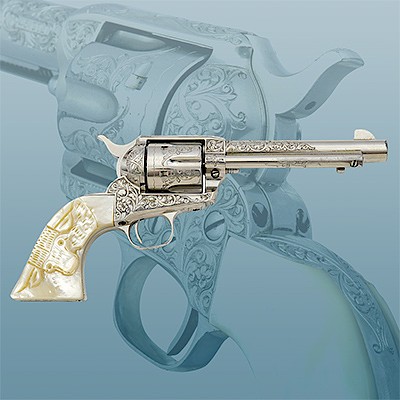Fine Maastricht-School Ivory-Stocked Wheel-lock Pistol
About Seller
250 Commercial Street
Manchester, NH 03101
United States
Amoskeag Auction Company is a specialty firearms auction company based in New Hampshire. Our experience and location have allowed us to create a highly advantageous environment for marketing collectible firearms at auction. This environment coupled with our high level of integrity and rigorous work ...Read more
Two ways to bid:
- Leave a max absentee bid and the platform will bid on your behalf up to your maximum bid during the live auction.
- Bid live during the auction and your bids will be submitted real-time to the auctioneer.
Bid Increments
| Price | Bid Increment |
|---|---|
| $0 | $10 |
| $100 | $25 |
| $500 | $50 |
| $1,000 | $100 |
| $3,000 | $250 |
| $5,000 | $500 |
| $10,000 | $1,000 |
| $20,000 | $2,500 |
| $50,000 | $5,000 |
| $100,000 | $10,000 |
About Auction
Nov 17, 2018
Fine Antique and Collectable Sporting and Military Arms Featuring items from the collections of Cletus Klein, Tim Falvey, Dr. Jess Lewis, Dr. Louis C. March Jr., Roy Jinks & Others Amoskeag Auction Company amanda@amoskeagauction.com
- Lot Description
.54 cal, 14'' part octagon part round barrel with an oxidized bore. This is a very interesting and very well-made arm, very closely emulating antique guns made during the golden age of the Maastricht gunmakers in the Netherlands, prior to the period circa 1673. The barrel is a pleasing tarnished pewter patina showing remnants of oxidation staining with turned medials at the point of transition; it is marked ''SR'' on its underside. The top flats of the octagonal sections show light open flowing foliate scroll at front and rear, the rear panels with lengthwise striations accenting the background and providing a nice contrast, the top panel the longest of the three, continuing onto the short squarish tang. The lockplate itself is similarly engraved and has slightly convex edges. The intertwined engraving is quite lovely and the friction wheel itself shows a tiny bit of geometric bordering at its center. The dog head and its spring keeper are lightly chiseled and engraved with light floral engraving on the spring catch of the sliding cover. The friction wheel is exposed and is retained only by a simple dog at the bottom and the underside of the ''pan'' at the top. The interior of the lock is not as finely finished as we are used to and a number of the components show more modern manufacturing methods than the fine hand fitting seen on Renaissance examples. The stock is rather spartan for an arm with a rather complex hand-carved butt treatment. It is constructed of antique ivory, overall smooth and un-carved in character, without decoration save for the butt proper, rather unusual for an ornately carved arm. There are antique drying cracks present, a very thin 4 1/2'' sliver that was repaired quite some time ago along the ramrod channel, and the most prominent moderate crack appears to have been appropriately arrested and is tight. The butt is carved with a Romanesque head of a mustachioed gentleman wearing heavily peaked cap. Surmounting the crown is a small dragon, Griffin-like creatures left and right at his temples, this very nearly duplicating the work of famous gunmaker Jean Louroux, of Maastricht, his much more finely carved work can be seen in many illustrations, this clearly emulating that work very closely. As on the Louroux example, there is a grotesque at the rear of the head, feathers emanating from its mouth. The joint butt-to-stock is covered by a small brass of band with acanthus leaf decoration. The brass triggerguard shows nice quality engraving as well and features chiseled foliate front and rear extensions. The lock mechanism does not operate, the trip or sear was not manufactured in such a way that it's rearward movement will actually release the wheel catch. The friction wheel itself does not have very deep groove nor does it have very deep corresponding perpendicular grooves which serve to chip the pyrite, doubtless made only as a display piece. Really a very attractive arm made by a craftsman of some talent, ivory being an exceedingly difficult medium to work with, it is highly likely this was a Victorian era-Renaissance revival piece, produced from the time when it became fashionable to display such embellished arms in the home. overall a very attractive ''example'' piece emulating a relief carved Dutch Wheelock, very few of which are ever offered publicly on the secondary market. (38737-208) {ANTIQUE} [Dr. Louis C. March Jr. Collection]
- Shipping Info
-
Amoskeag Auction Company, Inc. will make every effort to ship items in a timely fashion. All items, with the exception of modern handguns, are shipped via UPS Ground unless other arrangements have been made. • All modern handguns are shipped via UPS Next Day Air service. • Buyer is responsible for any and all shipping charges. • Orders are shipped in the order in which they are paid. PICKING UP MERCHANDISE • OUR OFFICE WILL BE CLOSED MONDAY AND TUESDAY FOLLOWING THE SALE. No merchandise will be delivered on those days. We will resume normal business hours on Wednesday. • Our office hours are Monday through Friday - 8:00 am to 4:00pm. Please call ahead prior to arriving to pickup your merchandise.
-
- Buyer's Premium



 EUR
EUR CAD
CAD AUD
AUD GBP
GBP MXN
MXN HKD
HKD CNY
CNY MYR
MYR SEK
SEK SGD
SGD CHF
CHF THB
THB
















